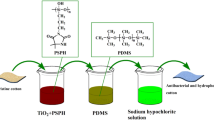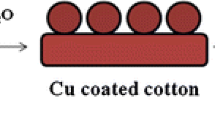Abstract
The present study investigated the potential antibacterial property of conductive cotton and polyester (PES) fabric coated with polyaniline (PANI). Phytic acid (10, 20, and 30% v/v) was used as a dopant. The fabricated fabric was produced via immersion technique with an immersion time of 30 minutes. The structural identification, conductivity, and morphological properties of prepared fabric were characterised with Fourier transform infrared spectroscopy (FT–IR), electrochemical impedance spectroscopy (EIS), and field emission scanning electron microscope (FESEM), respectively. The optimum conductivities of 2.28 × 10–4 S/m (for cotton) and 2.15 × 10–2 S/m (for PES) were recorded when doped with 30% (v/v) phytic acid. The antibacterial test showed that the fabricated fabric had relatively high antibacterial activity against K. pneumoniae, S. aureus, and E. coli strains.






Similar content being viewed by others
References
B. Simoncic, B. Tomsic, Structures of novel antimicrobial agents for textiles. A review. Text. Res. J. 80(16), 1721–1737 (2010)
R. Hirase, M. Hasegawa, M. Shirai, Conductive fibers based on poly(ethylene terephthalate)–polyaniline composites manufactured by electrochemical polymerization. J. Appl. Polym. Sci. 87(7), 1073–1078 (2003)
J. Molina, A.I. del Río, J. Bonastre, F. Cases, Electrochemical polymerisation of aniline on conducting textiles of polyester covered with polypyrrole/AQSA. Eur. Polym. J. 45(4), 1302–1315 (2009)
A.C. Aksit, N. Onar, M.F. Ebeoglugil, I. Birlik, E. Celik, I. Ozdemir, Electromagnetic and electrical properties of coated cotton fabric with barium ferrite doped polyaniline film. J. Appl. Polym. Sci. 113(1), 358–366 (2009)
S.K. Dhawan, N. Singh, S. Venkatachalam, Shielding effectiveness of conducting polyaniline coated fabrics at 101GHz. Synth. Met. 125(3), 389–393 (2002)
K.H. Hong, K.W. Oh, T.J. Kang, Polyaniline–nylon 6 composite fabric for ammonia gas sensor. J. Appl. Polym. Sci. 92(1), 37–42 (2004)
G. Tsekouras, S.F. Ralph, W.E. Price, G.G. Wallace, (2004). Gold recovery using inherently conducting polymer coated textiles. Fibers Polym. 5(1), 1–5 (2004)
G. Kaur, R. Adhikari , P. Cass, M. Bown, P. Gunatillake, Electrically conductive polymers and composites for biomedical applications. RSC. Adv. 5, 37553–37567 (2015)
S.K. Dhawan, N. Singh, S. Venkatachalam, Shielding behaviour of conducting polymer-coated fabrics in X band, W-band and radio frequency range. Synth. Met. 129(3), 261–267 (2002)
R.V. Gregory, W.C. Kimbrell, H.H. Kuhn, Conductive textiles. Synth. Met. 28(1–2), 823–835 (1989)
G. Tsekouras, S.F. Ralph, W.E. Price, G.G. Wallace, Gold recovery using inherently conducting polymer coated textiles. Fibers Polym. 5(1), 1–5 (2004)
T. Hai Le, Y. Kim, H. Yoon, C. Polymers, Electrical and electrochemical properties of conducting polymers. Polymers (Basel), 9(4), 150 (2017)
Hassan, H. K., Atta, N. F., & Galal, A., Electropolymerization of aniline over chemically converted graphene-systematic study and effect of dopant. Int. J. Electrochem. Sci. 7, 11161–11181 (2012)
A. Eftekhari, L. Li, Y. Yang, Polyaniline supercapacitors. J. Power Sources 347, 86–107 (2017). https://doi.org/10.1016/j.jpowsour.2017.02.054
D. Mawad, C. Mansfield, A. Lauto, F. Perbellini, G.W. Nelson, J. Tonkin, S.O. Bello, D.J. Carrad, A.P. Micolich, M.M. Mahat, J. Furman, D. Payne, A.R. Lyon, J. Justin Gooding, S.E. Harding, C.M. Terracciano, M.M. Stevens, A conducting polymer with enhanced electronic stability applied in cardiac models. Sci. Adv. 2, 11, e1601007 (2016)
L. Pan, G. Yu, D. Zhai, H.R. Lee, W. Zhao, N. Liu, H. Wang, B.C.-K. Tee, Y. Shi, Y. Cui, Z. Bao, Highly electroactive conducting polymer hydrogel. Proc. Nat. Acad. Sci. 109(24), 9287–9292 (2012). https://doi.org/10.1073/pnas.1202636109
R. Julia, G.N. Marija, K. N. Michel, S. Simon, The antimicrobial action of polyaniline involves production of oxidative stress while functionalisation of polyaniline introduces additional mechanisms. PeerJ. 6, e5135 (2018)
J. Robertson, M. Gizdavic-nikolaidis, M.K. Nieuwoudt, The antimicrobial action of polyaniline involves production of oxidative stress while functionalisation of polyaniline introduces additional mechanisms. PeerJ 6, e5135 (2018). https://doi.org/10.7717/peerj.5135
N. Shi, X. Guo, H. Jing, J. Gong, C. Sun, K. Yang, Antibacterial Effect of the Conducting Polyaniline. J. Mater. Sci. Technol. 2(22), 289–290 (2006)
D. Nicolas-Debarnot, F. Poncin-Epaillard, Polyaniline as a New Sensitive Layer for Gas Sensors. Anal. Chim. Acta 475(1-2), 1–15 (2003). https://doi.org/10.1016/S0003-2670(02)01229-1
J. Molina, M.F. Esteves, J. Fernández, J. Bonastre, F. Cases, Polyaniline coated conducting fabrics . Chemical and electrochemical characterization. Eur. Polym. J. 47(10), 2003–2015 (2015)
F. Kanwal, A. Gul, T. Jamil, Synthesis of acid doped conducting polyaniline. J. Chem. Soc. Pak. 29(6), 553–557 (2007)
K.M. Ziadan, W.T. Saadon, Study of the electrical characteristics of polyaniline prepeared by electrochemical polymerization. Energy Procedia 19, 71–79 (2012). https://doi.org/10.1016/j.egypro.2012.05.184
Nurzatul, S., Omar, I., Zainal Ariffin, Z., Akhir, R. M., Izzharif, M., Halim, A.,… Mahat, M. M. (2018). Electrically Conductive Polyester Fabrics Embedded Polyaniline. Int. J. Eng. Technol. 7, 524–528. Retrieved from www.sciencepubco.com/index.php/IJET
A. Mostafaei, A. Zolriasatein, Synthesis and characterization of conducting polyaniline nanocomposites containing ZnO nanorods. Prog. Nat. Sci.: Mater. Int. 22(4), 273–280 (2012)
Rehnby, W., Gustafsson, M., & Skrifvars, M., Coating of textile fabrics with conductive polymers for smart textile applications. Welcome to Ambience’08, (December), 100–103. Retrieved from http://bada.hb.se/bitstream/2320/3936/1/Ambience08.pdf#page=58 (2008)
A. Kaynak, R. Foitzik, Methods of Coating Textiles with Soluble Conducting Polymers. Res. J. Text. Appar. 15(2), 107–113 (2011). https://doi.org/10.1108/RJTA-15-02-2011-B012
R. Perumalraj, Electrical Surface Resistivity of Polyaniline Coated Woven Fabrics. J. Textile Sci. Eng. 05(03) (2015). https://doi.org/10.4172/2165-8064.1000196
The 411 on cotton vs polyester : The pros and cons. (2018, February 14). Retrieved from https://doi.org/10.1016/j.actbio.2011.018
M.R. Gizdavic-Nikolaidis, J.R. Bennett, S. Swift, A.J. Easteal, M. Ambrose, Broad spectrum antimicrobial activity of functionalized polyanilines. Acta Biomater. 7(12), 4204–4209 (2011). https://doi.org/10.1016/j.actbio.2011.07.018
M. Mashkour, M. Rahimnejad, M. Mashkour, Bacterial cellulose-polyaniline nanobiocomposite: A porous media hydrogel bioanode enhancing the performance of microbial fuel cell. J. Power Sources 325, 322–328 (2016). https://doi.org/10.1016/j.jpowsour.2016.06.063
N. Muthukumar, G. Thilagavathi, Development and characterization of electrically conductive polyaniline coated fabrics. Indian J. Chem. Technol. 19(6), 434–441 (2012)
Acknowledgements
Authors gratefully thank Institute of Research Management & Innovation (IRMI) Universiti Teknologi MARA (UiTM), Malaysia, for funding this project under GIP (600-IRMI 5/3/GIP (010/2019) – Electronic and Antibacterial Properties of Polyaniline Coated on Polyester Fabrics.
Author information
Authors and Affiliations
Corresponding authors
Electronic supplementary material
ESM 1
(PDF 178 kb)
Rights and permissions
About this article
Cite this article
Omar, S.N.I., Zainal Ariffin, Z., Zakaria, A. et al. Electrically conductive fabric coated with polyaniline: physicochemical characterisation and antibacterial assessment. emergent mater. 3, 469–477 (2020). https://doi.org/10.1007/s42247-019-00062-4
Received:
Accepted:
Published:
Issue Date:
DOI: https://doi.org/10.1007/s42247-019-00062-4




